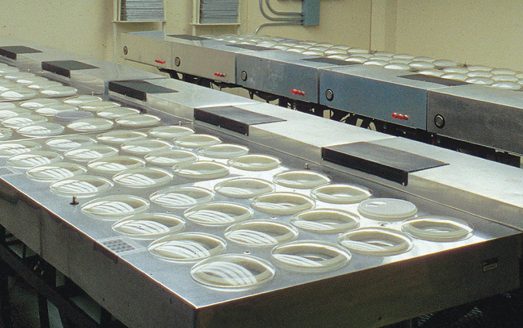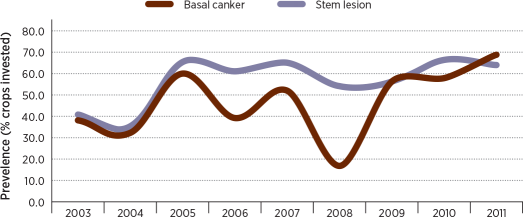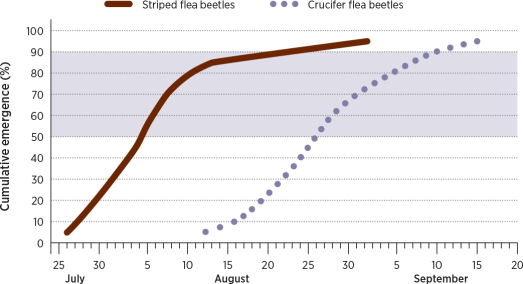Pest management

This study detected, monitored and managed various weed, disease and insect pests to find new ways to reduce their threat to the economic production of canola and the environmental health of Prairie agro-ecosystems. The study enhanced the potential for producers to successfully use integrated management of cyclical native pests and an increasing number of invasive species.
The ultimate aim is to develop novel assessment technologies and crop management tools for control of insects, weeds and diseases in canola. The study had four objectives: (1) develop and implement field surveillance technologies and laboratory assays; (2) develop novel forecast and risk assessment technologies; (3) determine ecological, biological, climatological and crop management relationships that influence pest status; and (4) develop new alternative integrated control and mitigation tactics.
OBJECTIVE 1 RESULTS
- Relative abundance of lygus bugs in weeds in the spring weeds has no relationship to lygus counts in canola later in the season.
- Sweep netting in canola at the pod stage likely severely underestimates the number of lygus nymphs.
- Weed surveys showed that weed species richness was higher than ever previously recorded. Species increasing since the 1970s include wild buckwheat, spiny annual sow-thistle, cleavers, barnyard grass, biennial wormwood, foxtail barley, round-leaved mallow and kochia. Species decreasing include lamb’s-quarters, stinkweed, annual smartweed species, field horsetail, wild mustard, Russian thistle, flixweed, bluebur and cow cockle.
- Insect survey protocols were developed and standardized.
OBJECTIVE 2 RESULTS
- Spatial analysis systems (Arc-GIS, SPANS) were used to summarize the distribution and density of insect pests (bertha armyworm, cabbage seedpod weevil, grasshoppers, pea leaf weevil, and wheat midge) into risk forecasts.
- A new field plot trial was initiated with Pest Management Centre support to investigate the impact of high densities of lygus feeding introduced at the bolting stage of canola development.
- Emergence of crucifer and striped flea beetles from early- and late-seeded canola varied yearly depending on the species, planting date and temperature. Striped flea beetles emerged two to three weeks earlier than crucifer flea beetles. Both species emerged one to five days sooner in early-seeded canola than in late-seeded canola. Both species also emerged earlier in years with aboveaverage temperatures than in years with below-average temperatures.
- A DYMEX model to simulate the development of sclerotinia stem rot has been developed and is coupled with a model for canola growth. A CLIMEX model for potential distribution and severity of sclerotinia stem rot has been developed. Models are still in the research realm.
- Given the size of clubroot resting spores, their dispersal with soil particles within a field or between adjacent fields can likely occur. It is unclear whether significant long distance transport of clubroot resting spores occurs via wind erosion, but there may be the potential for movement over tens to hundreds of kilometres. Conservation tillage and the avoidance of excessive soil disturbance will be keys to limit potential wind-mediated erosion.
OBJECTIVE 3 RESULTS
- Over three test years, flea beetle damage to canola was lower in early-seeded plots (14.6 percent) than in late-seeded plots (21.4 percent). Early seeding also improved canola yields by 12 percent.
- A study conducted at AAFC Saskatoon found that since 2009, populations of crucifer flea beetles have declined whereas populations of striped and hop flea beetles have increased. The shift in species was greater in early-seeded plots than in late-seeded plots.
- A three-year field investigation was conducted to see whether wheat stubble heights and soil preparation practices could deter feeding by flea beetles and root maggots in canola. Infestations of both pests were low for the duration of the three-year study, but trends suggest decreased feeding with increased stubble height.
- Bioclimate models were developed, using weather data and pest biology, to predict ecological and economic impact of invasive insect pests (lygus bugs, grasshoppers, cabbage seedpod weevil, diamondback moth, and cereal leaf beetle) in field crops in Western Canada. The results offer insights related to pest status and crop risk associated with changes in agronomic practices, new crops and a changing climate.
OBJECTIVE 4 RESULTS
- Field trials in 2010-2012 suggest that more effective seed treatments are needed for flea beetle control when cool, moist conditions prevail after seeding.
- Neonicotinoid seed treatments provide limited agronomic benefits when flea beetle damage is low and rainfall is above-average throughout most of the growing season.
- General Circulation Models were applied to bioclimatic models for a number of significant crop pest species, including grasshoppers, cereal leaf beetle, kochia and fusarium headblight, using weather data and pest biology to estimate the risk of these invasive insect pests in cereal and oilseed crops under a changing climate. Results indicated that all four crop pests would have increased range and relative abundance in more northern regions of North America, compared to predicted range and distribution under current climate conditions.
- New lines of crucifers were evaluated for resistance/susceptibility to flea beetle feeding. Hairy canola was as unpalatable to striped flea beetles as to crucifer flea beetles.
Figure 1. Blackleg in Manitoba 2003-2011

Figure 2. Cumulative emergence of striped flea beetles
(solid line; n = 4 years) and crucifer flea beetles (broken line; n = 8 years) from early-seeded plots at Saskatoon in 2004-2011

Principal investigators: Owen Olfert and Bob Elliott, Agriculture and Agri-Food Canada, Saskatoon, SK
Collaborators: Hector Carcamo, Julia Leeson, Debra McLaren, Jennifer Otani,
Gary Peng, Julie Soroka, Kelly Turkington
Published: Over the three years, 61 scientific papers, review articles and proceedings were derived from the study.




